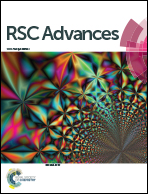Metal–organic nanofibers as anodes for lithium-ion batteries†
Abstract
Metal organic nanofibers (MONFs) synthesized from precursors of amino acid and copper nitrate were applied as anode materials for Li-ion batteries. Excellent cyclic stability as well as a moderate reversible capacity within the voltage range of 0.01–3.0 V were obtained (ca. 233 mA h g−1 at a current density of 50 mA g−1 following 200 cycles).


 Please wait while we load your content...
Please wait while we load your content...